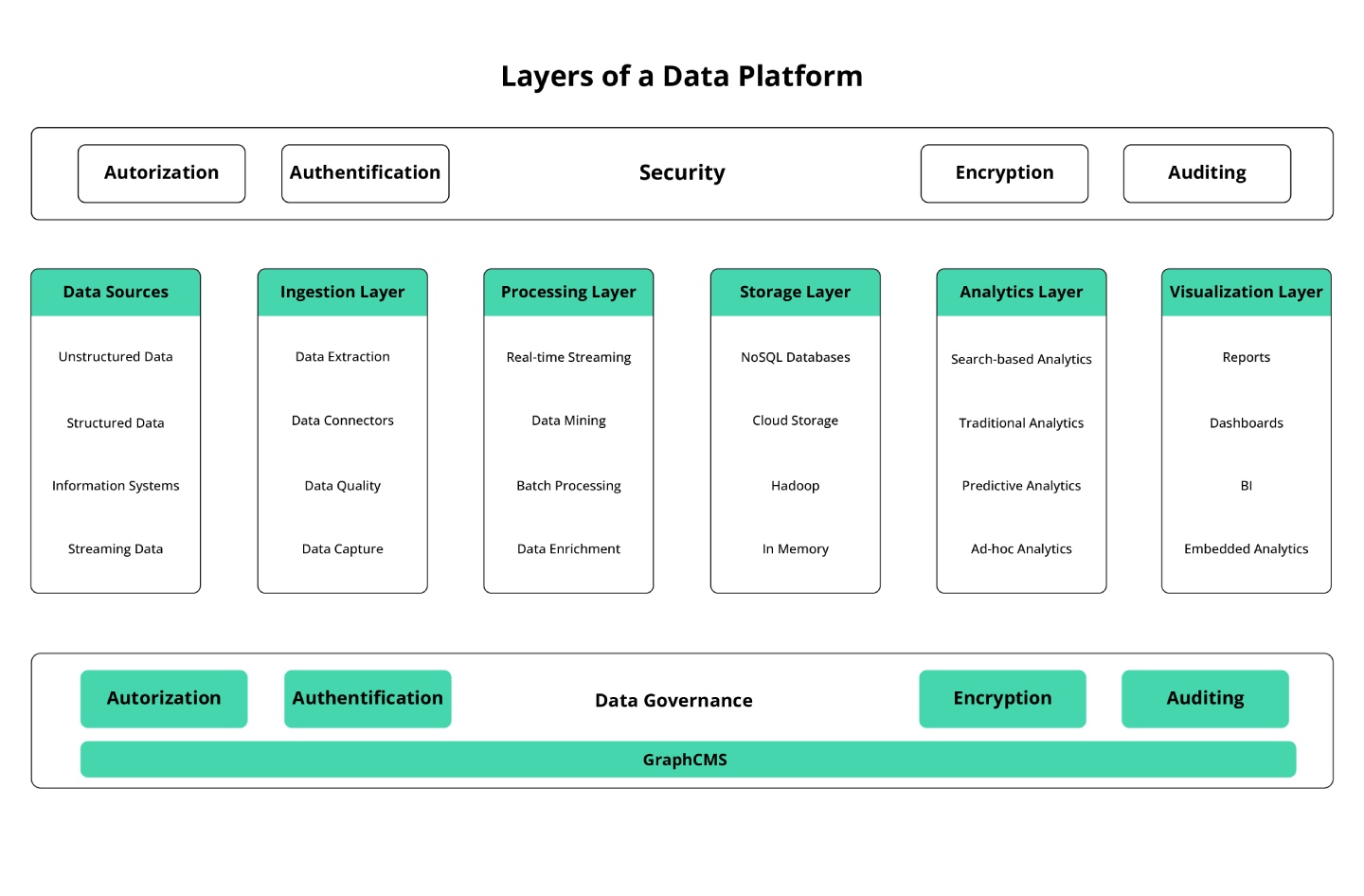A solid data governance program and data compliance practices improve data management and quality across the organization.
Effective data governance and regulatory compliance are hallmarks of data maturity. While most organizations aim to reduce regulatory risk and become more data-driven, many don’t have the internal resources to build governance and compliance solutions in-house. To keep up with the ever-evolving regulatory landscape and establish or scale robust governance programs, teams often work with a strategic partner like Intellias for strategic data solutions.
Intellias helps businesses across industries ensure data integrity and data compliance with cloud data governance. We take a value-focused approach, using our technological expertise to customize a solution that turns your data into a valuable business asset.
Core components of data compliance and governance solutions include:
- Alignment across data systems such as a CRM and ERP
- Data observability tools such as data catalogs
- A data governance framework tailored to your organization’s needs
- Tools that automate compliant data management processes
Data governance vs data compliance: Concepts to understand
Data governance and compliance are indispensable components of enterprise data lifecycle management.
- Data governance ensures data quality, availability, and security across the organization with internal rules that ensure data is managed, accessed, and used appropriately.
- Data compliance ensures that the organization adheres to regulations and laws governing data handling, protection, and privacy, minimizing legal and financial risks.
People who are new to these concepts sometimes need help to tell the difference between data governance and data compliance. While both focus on data management controls, the key is remembering how the scope of data governance and data compliance differ.
Data governance primarily concerns internal rules, while data compliance relates to external standards, laws, and regulations. In a nutshell, organizations govern their own data and comply with external regulations.
Look over this table for a more comprehensive comparison of data governance and data compliance:
Data governance vs. data compliance
| Data Governance | Data Compliance | |
|---|---|---|
| Objective | Control the organization’s data assets | Ensure legal and regulatory compliance |
| Primary Focus | Ensuring data quality, security, visibility, and appropriate access rights for enterprise data | Adhering to laws, regulations, and standards related to data privacy and protection |
| Scope | Setting and meeting internal policies and procedures for data management | Meeting external legal requirements and industry standards |
| Responsible Roles |
|
|
| Examples of Activities |
|
|
| Outcome | Increased value of business data since decision-makers can find the data they need and rely on data quality | Protection from legal and financial penalties, maintaining trust |
How do data governance and compliance differ in an organizational context?
We’ve established that the scope of data governance is mostly internal rules, and the scope of data compliance is primarily external rules. Here’s what that difference between data governance and data compliance looks like in an organizational context:
- Motivation: Business objectives drive data governance, while compliance aims to reduce risk by meeting legal requirements.
- Agency: Organizations can be proactive about establishing internal controls for data governance. On the other hand, data compliance is always reactive, responding to new or changing regulations set by external bodies.
- Oversight: Data governance policies that don’t directly relate to compliance are under internal control, whereas regulatory bodies may audit data compliance policies.
- Risk: Poor data governance could lead to data silos, bad data quality, and a lack of trust in organizational data, leading to missed opportunities or bad decisions. Failed compliance—which can result from inadequate data governance—could lead to legal consequences, fines, and reputational damage.
- Challenges: The main difficulties for data governance are avoiding misalignment across multiple systems, such as the company’s CRM and ERP, and balancing data visibility and access with data security, privacy, and compliance. Compliance’s primary challenge is keeping track of new and evolving regulations. Staff adherence to policies is a shared challenge.
End users within the organization may not notice a difference between internal data governance policies and externally imposed compliance rules because they are both embedded in the tools and policies that control data access.
In what ways does data governance support compliance efforts?
While data governance differs from data compliance, it must also work in tandem with compliance. An organization’s internal data governance processes are its best avenue for ensuring adherence to regulations.

Ways data governance supports compliance:
- Alignment with business users: Data governance frameworks balance compliance risks with business users’ demands for speed and visibility.
- Flexibility and scalability: A data governance framework must build in flexibility to accommodate inevitable changes to the regulatory environment.
- Creating visibility across the organization: Regulatory compliance requires visibility into enterprise-wide data. Governance policies that prevent misalignment across systems ensure compliance officers can see where data is, who has access, and how it’s been used, which speeds up compliance audits.
- Implementation of controls: Data governance tools and policies can ensure compliance, for example, limiting access to data, operationalizing mandated data protections like data masking or encryption, or documenting data lineage required by regulations like GDPR and HIPAA.
- Change management and staff training: Data governance isn’t just about tools and policies; there is a behavioral science aspect to designing processes. Good governance frameworks enact controls in user-friendly ways and ensure adherence to the processes that ensure ongoing compliance.
Can an organization have data governance without being compliant, or vice versa?
Since data governance can do so much to support data compliance, some might think they always work in tandem. Unfortunately, data governance doesn’t guarantee compliance, and vice versa.
Governance alone isn’t enough because internal data governance policies that are effective for maintaining data quality, accuracy, and availability won’t necessarily meet external legal or regulatory requirements. For example, an organization with highly effective data management practices could fall short of compliance with regional laws, like GDPR or CCPA, or industry regulations, like HIPAA or SOX. This organization could be unwittingly breaking laws, at the risk of hefty fines and unflattering headlines.
On the other hand, an organization could meet the bare minimum required by data regulations but stop short of developing a comprehensive data governance framework. Since this organization would not have a mature program for managing the data lifecycle, it would face data quality and availability problems. The lack of governance could result in bad forecasting, poorly informed decisions, security risks, and lost business opportunities.
Compliance and governance are both necessary and need to work in close alignment to ensure business success and reduce regulatory risk.
What are the challenges in aligning data governance with compliance?
On paper, it’s clear that good data governance should support compliance efforts, and compliance should reinforce sound governance practices. But, since they serve different purposes, it can be tricky to align data governance and compliance in a real organizational context.
The biggest challenges of aligning data governance and data compliance include:
- Complex, evolving regulations: Governance frameworks can’t always adapt quickly enough to keep up with changing laws.
- Siloed data management: Isolated systems make it hard to see data across the enterprise and enforce governance and compliance consistently.
- Resource and budget constraints: Aligning efforts can require significant investments in technology, personnel, and processes.
- Data quality and human error: Real data can be messy, and errors or quality control issues that misclassify data or hamper data access pose problems for governance and compliance alike.
- Audit trails and reporting: Comprehensive monitoring and reporting can be challenging for meeting both governance and compliance needs.
- Cultural alignment: Collaboration across departments (IT, Legal, Security) is essential but can be difficult when teams have different goals and priorities.
The Intellias experience: A data governance and compliance case study
A major European telecom company based in Bonn, Germany, came to Intellias with a pressing issue. The company was preparing to outsource key business applications and needed to secure sensitive data while remaining compliant with GDPR. Its existing data governance framework wasn’t up to the task. Without a more robust solution, they could face fines, data breaches, and operational chaos.
Our cloud governance experts quickly built a compliant solution that tackled all these challenges head-on. Using Apache Atlas as the backbone, we created a comprehensive data governance framework that allowed the telecom giant to trace data lineage, manage sensitive information, and meet compliance requirements for GDPR.
This solution not only met the client’s immediate needs but also positioned them for long-term success. Here’s what we achieved together:
Governance and compliance solution:
- Apache Atlas: To manage data lineage and provide full transparency across all systems
- Encryption and access controls: Protecting sensitive data from unauthorized access and ensuring GDPR compliance
- Business intelligence tools: Enabling better decision-making with clear, actionable insights from data
- Secure outsourcing framework: Allowing the company to safely engage third-party vendors without risking data integrity or security
Far-reaching business benefits:
- Outsourcing concerns allayed: Ensured safe and compliant handling of sensitive data by third-party vendors
- Improved compliance posture: Strengthened adherence to GDPR and other regulations
- Increased operational efficiency: Streamlined data management, reducing redundancies
- Enhanced data quality: Improved accuracy and reliability of business intelligence reports

Accelerate your data maturity with governance and compliance
As data, data regulations, and regulatory fines all keep growing at astonishing rates, effective data governance and compliance can’t be afterthoughts. Both are critical components of a mature data management program.
Data governance ensures your data’s quality, availability, and security, while compliance protects your organization against legal and regulatory risks. Aligning these efforts can be challenging, but it’s essential for keeping your business strong and healthy in a data-driven world.
At Intellias, we’ve seen firsthand how much organizations stand to gain with a custom governance framework and diligent compliance. Our expertise in governance and security for cloud infrastructures can accelerate your data maturity journey, protecting your business and maximizing the value of your data.
For help with your data governance and compliance challenges, contact our team today.


